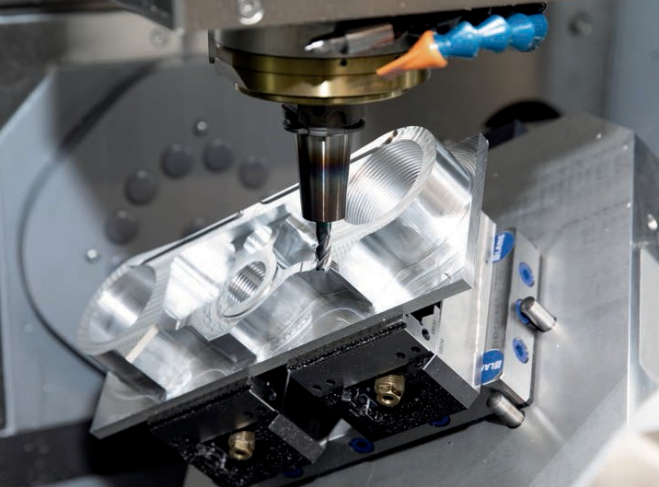
1. The method of preventing damage from cutting tools
1-1 According to the characteristics of processed materials and parts, a reasonable selection of tool materials of various types and brands. Under certain hardness and wear resistance, we need to guarantee the necessary toughness of the tool material.
1-2 Reasonable selection of geometric tool parameters. Adjusting the front and rear angles, main and auxiliary declination angles, edge dip angles, etc. Ensure the cutting edge and tip have good strength. Grinding negative chamfering on the cutting edge is an effective measure to prevent tool collapse.
1-3 Ensure welding and grinding quality and avoid defects caused by poor welding and grinding. We should ground it to improve the surface quality and check for critical process cracks.
1-4 Reasonable selection of cutting parameters, avoiding excessive cutting force and high cutting temperature to prevent tool damage.
1-5 As far as possible, ensure the processing system has good rigidity and reduces vibration.
1-6 Take the correct operation method, as far as possible, so that the tool does not bear or bear the less sudden load.
2. Causes and solution of tool breakage
2-1. Improper selection of blade brand and specification, such as the thickness of the blade being too thin or the brand being too hard and brittle when roughing.
◆Solution: Increase the thickness of the blade or install the edge vertically, and choose the brand with high bending strength and toughness.
2-2. Improper selection of geometric tool parameters (such as too large front and rear angles).
◆Solution: we can redesign the tool from the following aspects.
(1) Appropriately reduce the front and rear angles.
(2) Adopt a sizeable negative edge Angle.
(3) Reduce the primary deflection Angle.
(4) Use sizeable negative chamfering or cutting-edge arc.
(5) Sharpen the transition cutting edge and strengthen the tip.
2-3 The blade's welding process is incorrect, resulting in excessive welding stress or cracks.
◆Solution:
(1) Avoid the blade groove structure closed on three sides.
(2) Correct selection of solder.
(3) Avoid using oxy-acetylene flame heating welding, and insulate it after welding to eliminate internal stress.
(4) Use a mechanical clamped structure as far as possible.
2-4. Wrong grinding method, resulting in grinding stress and grinding cracks; The vibration and swing of the cutter teeth after grinding the PCBN milling cutter is too large, so that the load of the individual cutter teeth is too heavy, and it will cause the cutting tool.
◆Solution:
(1) Use intermittent grinding or a diamond grinding wheel such as a vitrified diamond grinding wheel
(2) Choose a soft grinding wheel, often dressing to keep the grinding wheel sharp.
(3) Pay attention to grinding quality and strict control of the milling cutter teeth pendulum.
2-5. The selection of cutting parameters is not reasonable,such as
(1) the amount is too large, the cutting motion will stop;
(2)When intermittent cutting, the high cutting speed, the large feed, the blank margin is not uniform, and the too-small cutting depth;
(3)The feed is too small when cutting high manganese steel and other materials with significant work hardening tendency.
Solution: re-select cutting quantity.
2-6. The mechanical clamping tool groove bottom surface is not smooth, and the blade extends too long, and other structural reasons.
◆Solution:
(1) Trim the bottom surface of the knife groove.
(2) Reasonable arrangement of the position of the fluid cutting nozzle.
(3) The hardened tool rod has a carbide gasket under the blade.
2-7. Excessive tool wear.
◆Solution: Change the tool or change the cutting edge in time.
2-8. The cutting fluid flow is insufficient, or the filling method is incorrect, resulting in the blade's sudden heat and crack damage.
◆Solutions:
(1) Increase the flow of cutting fluid.
(2) Reasonable arrangement of the position of the fluid cutting nozzle.
(3) Adopt effective methods such as spray cooling to improve the cooling effect.
(4) Using cutting to reduce the impact on the blade.
2-9. Incorrect tool installation, such as: cutting tool installation too high or too low; Face milling cutter adopting asymmetric down milling, and so on.
◆Solution: Reinstall the tool.
2-10. The process system's rigidity is too poor, resulting in excessive cutting vibration.
◆Solutions:
(1) Increase the extra support of the workpiece, and improve the clamping rigidity of the workpiece.
(2) Reduce the overhang length of the tool.
(3) Appropriately reduce the back Angle of the tool.
(4) Adopt other vibration suppression measures.
2-11. Careless operation, such as cutting tool from the middle of the workpiece, the action is too fierce; Not yet back knife, that line stop.
◆Solution: Pay attention to the operation method.
3. The formation of debris tumors, characteristics, and control measures
3-1. Formation Reasons
Due to downforce, the tool-chip contact area near the cutting edge will form no gap between the actual metal contact and produce a bonding phenomenon. This part of the tool-chip contact area is called the bond area. In the bonding zone, In the chip bottom, a thin metal material layer will be deposited on the front of the cutter face; this part of the chip metal material has undergone severe deformation, hardening at the appropriate cutting temperature. With the continuous flow of chips pushed by the flow of subsequent cutting, this layer of hysteresis material slides away from the upper layer of chips. It becomes the foundation of the chip nodulation. Then, on top of it, a second layer of hysteresis cutting material is formed, which accumulates, including a chip burl.
3-2. Characteristics and their influence on machining
(1) The hardness is 1.5~2.0 times higher than the workpiece material, which can replace the front tool face for cutting, protecting the cutting edge and reducing the wear of the front tool face. However, the debris falling off when the debris flows through the tool-workpiece contact area will cause wear on the tool back tool face.
(2) After the formation of chip nodules, the working Angle of the tool increases significantly, which plays a positive role in reducing chip deformation and cutting force.
(3) Because the chip nodules protrude outside the cutting edge, the actual cutting depth increases, affecting the dimensional accuracy of the workpiece.
(4) Chip nodules will cause a "furrow" phenomenon on the workpiece surface and affect the roughness of the workpiece surface.
(5) The debris will bond or embed into the workpiece surface, causing hard points and affecting the quality of the workpiece's processed surface.
From the above analysis, we can see that chip nodules are unfavorable to cutting, especially finishing.
3-3. Control measures
Do not make the chip bottom material and the front cutter surface bonding or deformation strengthening, which can avoid the generation of debris nodular to this day can take the following measures.
(1) Reduce the roughness of the front tool surface.
(2) Increase the front Angle of the tool.
(3) Reduce the cutting thickness.
(4) Adopt low-speed or high-speed cutting to form chip nodules to avoid the easy cutting speed.
(5) Appropriate heat treatment of the workpiece material to improve its hardness and reduce plasticity.
(6) The cutting fluid with good anti-bonding performance (such as extreme pressure cutting fluid containing sulfur and chlorine) is used.
Contact: Nina Qiao
Phone: 8613526572721
E-mail: cutting@zy-superhardtools.com
Whatsapp:8613526572721
Add: AUX Industry,Zhengzhou City,Henan Province,China
We chat
